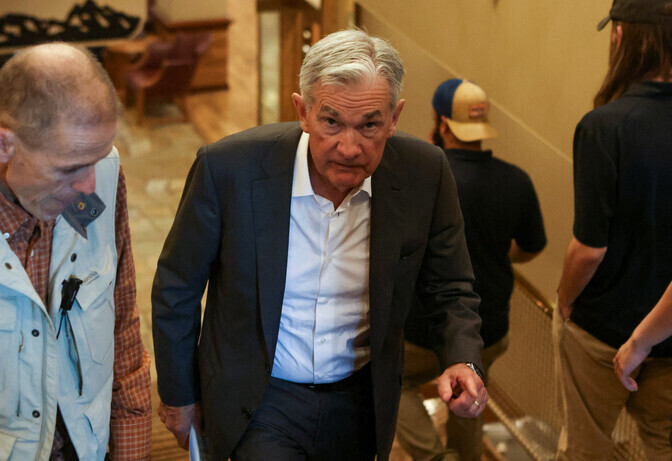hankyoreh
Links to other country sites 다른 나라 사이트 링크
As exchange rate soars, will US Fed agree to currency swap with S. Korea?

With the won-dollar exchange rate approaching the 1,400 won mark, the focus is now on whether the US Federal Reserve will agree on a temporary currency swap agreement with South Korea.
While South Korea is actively requesting a currency swap deal, which would result in a contract that would allow Seoul to borrow a certain amount of US dollars for a predetermined period and rate in exchange for won, it’s ultimately up to the Fed to make the final decision after considering the stability of the global foreign exchange market and other factors.
As such, Seoul has no choice but to wait and watch what will happen.
“It is true that we are pushing [the Fed] for a currency swap more aggressively than before because of the exchange rate,” a high-ranking official in the foreign exchange field told the Hankyoreh on Wednesday.
The same official shared that they were “aware that the working group [for the upcoming South Korea-US summit] added the signing of a South Korea-US currency swap agreement to the agenda.”
However, the size of the currency swap that is being requested by South Korea and the current attitude of the Fed remain unknown.
In the past, the Fed has made decisions on currency swaps based purely on economic and financial logic, such as when many countries face difficulties securing dollar liquidity.
If signed, the market estimates that the currency swap could be worth more than US$60 billion.
If the dollars raised by the currency swap deal are immediately supplied to the domestic dollar fund, it could possibly pump the brakes on the recent climb in the won-dollar exchange rate.
South Korea and the US have concluded two temporary currency swap agreements to date.
The first ran from November 2008 through February 2010, totaling US$30 billion, and came on account of the global financial crisis. The second agreement was double the amount of the first, at US$60 billion, and was in effect from March 2020 to December 2021. This second agreement came after the shock of the COVID-19 pandemic. For the second agreement, a total of nine countries, including South Korea, extended the currency swap agreement by six months.
The Fed currently has a “permanent” currency swap agreement in place with five partners, namely the EU, Japan, the UK, Canada and Switzerland and has also signed temporary emergency currency swap deals (for six months) with other countries when deemed necessary.
If another deal with South Korea is reached this time, then it’s possible that the Fed will also simultaneously sign temporary currency swap agreements with five or six other countries.
“If the Fed announces a currency swap this time, it will adjust [the agreement] as it deems necessary within the scope of its currency swap policy,” the foreign exchange official said.
“The Fed is greatly independent [from the US government]. The US government’s opinion is not decisive and there is a tendency for the Fed to make the decisions and [official] announcements,” the official added.
With currency swap agreements, there are negotiation channels between central banks, but the Fed has a strong tendency to make independent decisions while taking into consideration the global foreign exchange market and the overall stability of the value of the US dollar.
By Cho Kye-wan, senior staff writer; Park Jong-o, staff reporter; Choi Ha-yan, staff reporter
Please direct questions or comments to [english@hani.co.kr]

Editorial・opinion
![[Guest essay] The real reason Korea’s new right wants to dub Rhee a founding father [Guest essay] The real reason Korea’s new right wants to dub Rhee a founding father](https://flexible.img.hani.co.kr/flexible/normal/500/300/imgdb/original/2024/0423/8317138574257878.jpg) [Guest essay] The real reason Korea’s new right wants to dub Rhee a founding father
[Guest essay] The real reason Korea’s new right wants to dub Rhee a founding father![[Column] ‘Choson’: Is it time we start referring to N. Korea in its own terms? [Column] ‘Choson’: Is it time we start referring to N. Korea in its own terms?](https://flexible.img.hani.co.kr/flexible/normal/500/300/imgdb/original/2024/0423/3617138579390322.jpg) [Column] ‘Choson’: Is it time we start referring to N. Korea in its own terms?
[Column] ‘Choson’: Is it time we start referring to N. Korea in its own terms?- [Editorial] Japan’s rewriting of history with Korea has gone too far
- [Column] The president’s questionable capacity for dialogue
- [Column] Are chaebol firms just pizza pies for families to divvy up as they please?
- [Column] Has Korea, too, crossed the Rubicon on China?
- [Correspondent’s column] In Japan’s alliance with US, echoes of its past alliances with UK
- [Editorial] Does Yoon think the Korean public is wrong?
- [Editorial] As it bolsters its alliance with US, Japan must be accountable for past
- [Guest essay] Amending the Constitution is Yoon’s key to leaving office in public’s good graces
Most viewed articles
- 1[Column] ‘Choson’: Is it time we start referring to N. Korea in its own terms?
- 2Why Korea shouldn’t welcome Japan’s newly beefed up defense cooperation with US
- 3Senior doctors cut hours, prepare to resign as government refuses to scrap medical reform plan
- 4[Guest essay] The real reason Korea’s new right wants to dub Rhee a founding father
- 5Samsung barricades office as unionized workers strike for better conditions
- 6Opposition calls Yoon’s chief of staff appointment a ‘slap in the face’
- 7[Column] The clock is ticking for Korea’s first lady
- 8[Editorial] Japan’s rewriting of history with Korea has gone too far
- 9New AI-based translation tools make their way into everyday life in Korea
- 10Terry Anderson, AP reporter who informed world of massacre in Gwangju, dies at 76